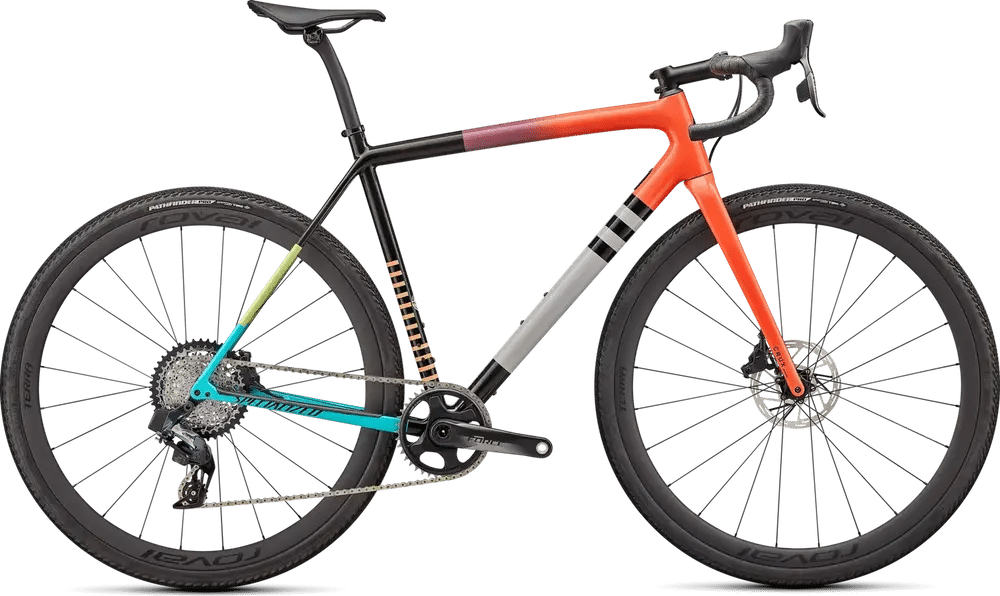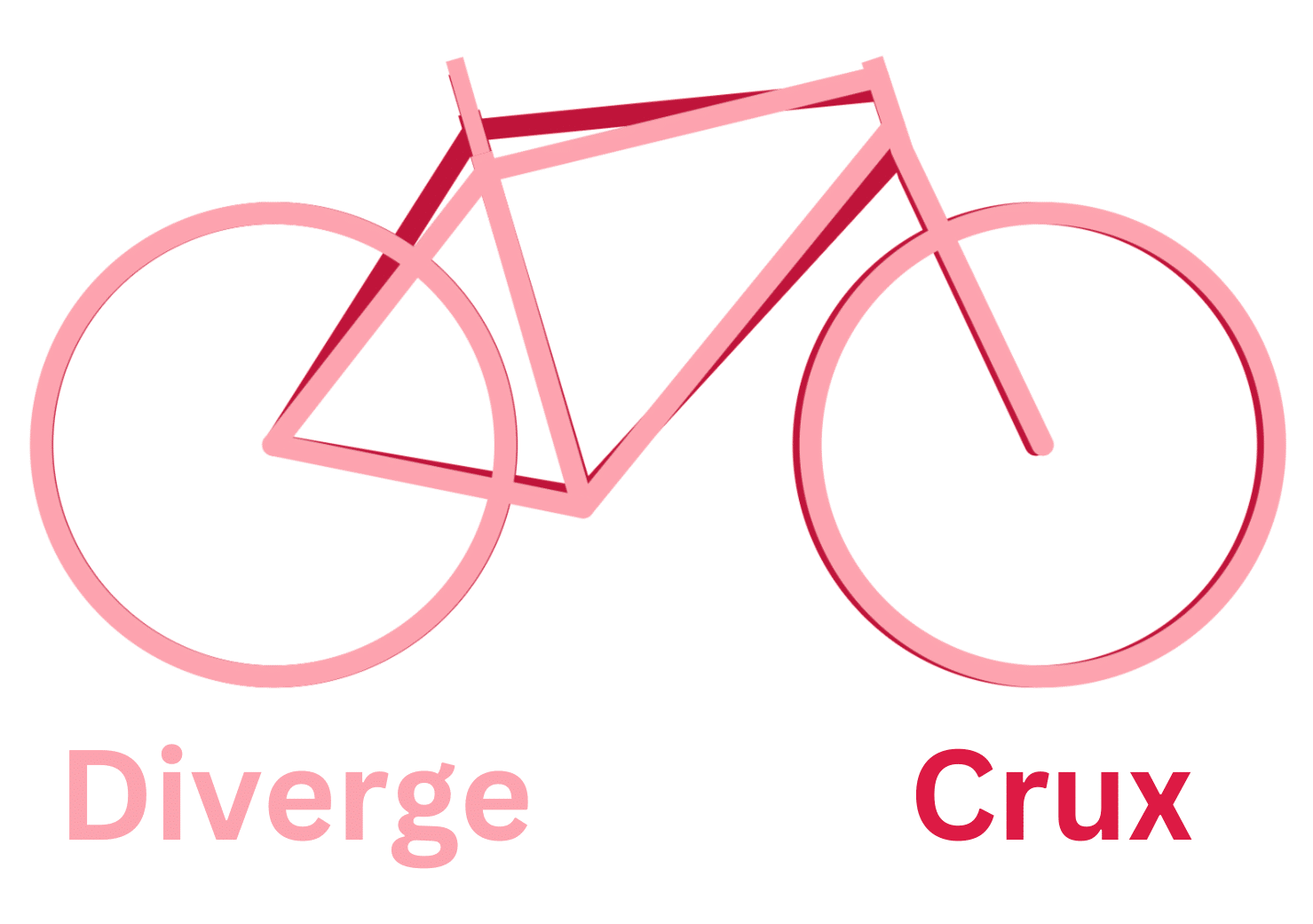The Specialized gravel bike battle! Which bike is best?
We are going to compare these two iconic gravel bikes side by side and see what the difference is between each.
When it comes to price the Diverge ranges from $1,100 to $14,000 while the Crux ranges from $4,200 to $14,245.
But what really is the difference and which one is best for you and your riding goals?
There are so many different models to choose from for each bike.
For this article, we have taken their mid-range (best bang for buck option as a main comparison, as well as their most affordable and most expensive options, along with a couple of other choices. Instead of comparing the entire list of models together.)
The Specialized Diverge is probably the most perfect all-rounder gravel bike. At home as a bikepacking bike, just as efficient on the group rides with your roadie mates.
It provides the goods for a range of cycling disciplines. Allowing you to ride fast on gravel roads, and much more.
On the other hand, the Crux could be mistaken for just another gravel bike with not much difference from the Diverge.
However, the Crux is officially considered a cyclocross bike. Made more for racing than the Diverge. And this is evident in the following information we have included below.
The bikes we compared were the Specialized Diverge STR Expert vs Specialized Crux Pro.
Both are respectively higher-end models. Also, the Diverge is available in suspension options. The STR models have a rear shock near the seat stay and dampening technology in the fork.
When comparing the Crux and Diverge, the Diverge is approximately 8.6 kg while the crux is dubbed one of the lightest “gravel bikes” you can buy at around 6.9kg (16.21 lb) for their lightest model.
While other baseline options are 8.5 kg. Weight really differs depending on home much you spend.
The Diverge is a little more focused on adventure geometry which is more comfortable the longer you stay in the saddle.
Offering more mounting options to carry all the necessary gear you may need for a bikepacking trip.
When it comes to tire clearance the Diverge can fit up to 700c x 47mm or 2.1″ x 650b, while the Crux can fit the same.
Both vary when it comes to gearing and brakes. With the Crux more tuned on the high end while the Diverge is slightly more capable on the low end for climbing.
Different tires with Crux running Pathfinder Pro 38 mm and Diverge on Tracer Pro 42 mm tires, but again it really depends on the model you get as tires also differ.
The main difference is in the bike’s geometries.
The Crux features a more aggressive stack/reach ratio (1.46 vs 1.55), the chainstay is the same (around 425 mm on medium-sized) or slightly shorter on the Crux (depending on models) and Wheelbase is approx 11 mm longer on the Diverge on models we compared.
Again making for a more planted feel when under a load.
The trail is roughly 7 mm larger on the Crux, meaning the Crux surprisingly has a slower and calmer steering response compared to the Diverge.
Between the two and the standover height is around 38 mm lower on the Diverge.
The Bottom Bracket drop on the Diverge is about 13 mm lower than the Crux and the Crux has a higher bottom bracket height of 21 mm.
This means the Diverge is better opted for riding with gear and making the bike feel planned when under a load.
Also when taking a look at these bikes’ gearing with the example models mentioned above, we found that the Crux has a 25.01″ climbing gear and 109.92″ largest gear.
That’s a 0.91 to 4.00 gear ratio. Which is pretty expected for a racing gravel bike/cyclocross bike.
While the Diverge had a better climbing gear with 22.24″ and 101.17″ for the largest gear, combined with slightly wider stock tires.
This improved climbing gear makes it a better option as a bikepacking gravel bike compared to the Crux.
Specialized Diverge

The Diverge encompasses more than 40 years of riding road, gravel, and dirt experiences, into the perfect do-it-all package.
Whether you’re looking for a bike for that challenging gravel race. Or you want to satisfy your adventurous side.
The Diverge can take you to most places and rather fast if you insist.
With future shock technology to dampen those bumpy roads, all-new gravel geometry, internal storage, and category-leading tire clearance.
The Diverge is one of the most innovative gravel bikes on the market. Specialized continues to improve and iterate.
It has been used in some long-distance endurance events. Featuring a spot amongst some of the fastest gravel bikes.
Specialized Crux

Self-proclaimed as the world’s lightest gravel bike. The Specialized S-Works Crux is said to weigh 6.9kg (16.21 lb), which is their top-of-the-line option.
While the Crux Comp weighs in at 8.5 kg (18.73 lb), which is their baseline model.
Offering some of the best tire clearance-to-weight ratios on the market with the option to run up to 47c tires while also offering a performance gravel geometry.
With a 1.46 stack/reach ratio for a 56cm frame. The performance-focused geometry “creates the feeling of being ‘in’ the bike for incredible confidence while still feeling quick and nimble at the bars.”
To get lightweight gravel bike status the Crux had to drop the rack, fender, and bag mounts allowing riders to engage in a straightforward riding experience.
Making it not the ideal bike for bikepacking in this regard, you can still mount bags though.
Also, the bike provides a 10mm longer reach to give riders a more ideal weight distribution and the shorter stem offers more controlled steering.
Geometry – Diverge Vs Crux

Geometry can play a big part in the difference between how a bike rides and feels. It is definitely something to consider when buying a bike.
Want to learn more about understanding bike geometry? Read this article which goes through all the jargon and what it means for a comfortable ride!
At first impressions, I was expecting the Crux to be more of a road bike geometry with more aggressive angles.
And that provided to be true with the slightly shorter chainstay and wheelbase for more responsive and snappy control.
And shorter stack/reach ratio. But all the measurements below are in mm and are for both medium-sized bikes or 56cm frames.
| Bike | Diverge | Crux |
| Stack | 609 | 578 |
| Reach | 382 | 397 |
| Stack/Reach Ratio | 1.55 | 1.46 |
| Top Tube Length | 570 | 568 |
| Seat Tube Length | 500 | 546 |
| Seat Tube Angle | 74 | 73.5 |
| Head Tube Length | 130 | 147 |
| Head Tube Angle | 71.75 | 72 |
| BB Drop | 85 | 72 |
| Front Center | 629 | 618 |
| Chainstay Length | 429 | 425 |
| Wheelbase | 1044 | 1033 |
| Rake | 55 | 50 |
| Trail | 57 | 64 |
| Standover Height | 778 | 816 |
The main difference between the two bikes is the stack/reach ratio, being much more aggressive on the Crux.
Meaning the Diverge is better suited for a more upright riding position adding more comfort in the saddle for those long adventures.
This lower stack/reach would make the Crux more efficient and faster to ride, but sacrifice comfort.
Along with this the Chainstay and Wheelbase are longer on the Diverge making it feel a little more planted for loaded adventures.
And making the Crux a better bike for speed and performance.
You want a shorter chainstay in the rear for quick and snappy bike control.
If you plan to mostly go on adventures with gear the Diverge is a no-brainer.
But if you are looking for a speedy gravel bike that will keep up with your roadie mates the Diverge is still capable.
People still use the Diverge for bikepacking too.
However, if you want a bike to go fast and nothing else the Crux is your go-to.
With the lighter build and gearing for riding fast on the flats and downhill it’s just superior when it comes to performance and speed.
If you plan to cart gear and use your bike for transporting cargo in the form of bikepacking bags. You might be better off with the Diverge for its longer wheelbase to avoid heel striking when compared to a shorter wheelbase on the Crux.
This longer wheelbase adds better overall stability when the bike is under more of a load.
Also, the Diverge gives you more mounting options with a plethora of different eyelets for mounting racks, fenders, and bike bags.


